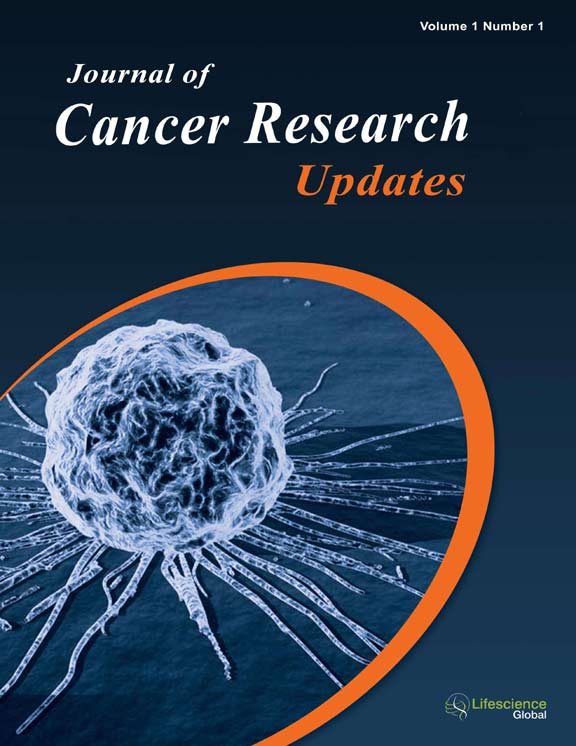jcru
Editor's Choice : The Polymorphism of EME1 Gene is Associated with an Increased Risk of Lung Cancer: A Case-Control Study from Chinese Population
|
|
Abstract: DNA double-strand breaks (DSBs) can lead to genomic instability and cancer susceptibility if unrepaired. EME1 is one of the key proteins that participate in the recognition and repair of DSBs in humans. We hypothesized that the exonic variants of EME1 are associated with lung cancer risk. In a two-stage case-control study of 1559 lung cancer patients and 1679 cancer-free controls, we genotyped two exonic variants of EME1(Glu69Asp: rs3760413T>G and Ile350Thr: rs12450550T>C) and analyzed their associations with risk of lung cancer. We found that the Asp variant genotypes conferred 1.35-folds risk of lung cancer compared to the Glu/Glu genotype (OR = 1.35, 95%CI = 1.18-1.56, P = 2.18 × 10-5) in both stages. However, the SNP Ile350Thr was not confirmed to be associated with cancer risk in both stages. Moreover, by querying the gene expression database, we further found that the 69Asp variant genotypes confer a significantly lower mRNA expression of EME1 than the Glu/Glu genotype in 260 cases of lymphoblastoid cells (P=0.013). Our findings suggested that the SNP Glu69Asp of EME1 is associated with an increased risk of lung cancer, and may be a functional biomarker to predict lung cancer risk in Chinese. Validations in other ethnics are warranted. Keywords: Lung cancer, EME1, exonic variant, functional biomarker.Download Full Article |
Editor’s Choice : Case Report: Coexistence of Non-Keratinizing Squamous Cell Carcinoma and Follicular Lymphoma in Nasopharynx
|
|
Abstract: We report a very rare case of coexistence of non-keratinizing nasopharyngeal carcinoma and follicular lymphoma in nasopharynx. A 52-year-old woman was admitted in our hospital because of painless enlarged bilateral cervical mass. Nasopharyngoscopy revealed a nasopharyngeal mass, and biopsy showed follicular lymphoma cells infiltrating non-keratinizing squamous carcinoma. The patient underwent combined treatment which targeted two tumors and was alive without any progression in one-year follow up. Keywords: Nasopharyngeal carcinoma, follicular lymphoma.Download Full Article |
Editor’s Choice : NACA (Nascent-Polypeptide-Associated Complex α Subunit) Against Apoptosis in B Lymphoma Cell is Independent of β Subunit (NACB)
|
|
Abstract: We found depletion of NACA in two kinds of B lymphoma cell lines, Raji and Kapas, were able to induce apoptosis in this study. We also explored whether depletion of β subunit had the same effect, and we were interested in which domain of NACA was potentially responsible to this anti-apoptosis function. Lentivirus-based shRNA was used to deplete endogenous NACA or NACB. Those cells’ viabilities were measured by Alamar-blueTM assay. Cell apoptosis was identified by molecular markers caspase9 and PARP, as well as cellular markers Annexin V and propidium iodide (PI) staining. NACA mutants were constructed by PCR site-directed mutagenesis and delivered into cells by Lentivirus. Immunofluoresce was used to investigate cellular distribution in 293FT cells. Our results demonstrated that the depletion of NACA, but not NACB, was able to induce apoptosis. Deletion of middle or C-term rather than N-term induced obvious apoptosis. The middle part of NACA was response to bind NACB and form a complex. Without middle part, NACA redistributed into nuclei. We conclude NACA against apoptosis is independent of β subunit. C-term of NACA, which is identified as ubiquitin binding domain, and may take important role in anti-apoptosis function. Keywords: NACA, B-cell lymphoma, anti-apoptosis, depletion mutant.Download Full Article |
Editor’s Choice : Patterns of Distant Failure and Second Primary Cancers in Patients with Oropharyngeal Squamous Cell Carcinoma: Implications for Surveillance Methodology
|
|
Abstract: Background: We analyzed the pattern of distant metastasis (DM) and secondary primary cancers (SPC) in patients with oropharyngeal squamous cell carcinoma (OPSCC) to develop surveillance guidelines. Methods: A retrospective review of 177 patients with OPSCC treated with intensity modulated radiation therapy ± chemotherapy between 2002 and 2012 was performed to characterize the rate, pattern, and timing of DM and SPC. Results: Sixteen patients (9.0%) developed DM and 9 patients (5.1%) developed a SPC. Overall, 24/177 patients (13.6%) developed a DM and/or SPC for a total of 27 events. 92.6% (25/27) of events were detectable on physical exam and/or chest CT. p16+ patients developed DM later than p16- tumors (23.4 months versus 8.7 months). Conclusions: Chest CT with physical examination detects the majority of DM and SPC in patients with OPSCC and would provide effective surveillance in these patients. A risk adapted surveillance strategy is proposed. Keywords: Oropharynx cancer, surveillance, survivorship care, distant metastasis, second primary cancer.Download Full Article |






















